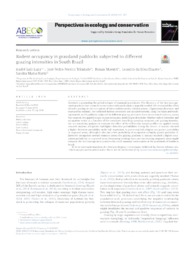Rodent occupancy in grassland paddocks subjected to different grazing intensities in South Brazil.
Rodent occupancy in grassland paddocks subjected to different grazing intensities in South Brazil.
Author(s): LUZA, A. L.; TRINDADE, J. P. P.; MAESTRI, R.; DUARTE, L. da S.; HARTZ, S. M.
Summary: tLivestock is promoting the global collapse of mammal populations. The discovery of the best manage-ment practices that reconcile conservation with production is urgently needed. We evaluated the effectof cattle grazing on the occupation of three rodent species (Akodon azarae, Oligoryzomys flavescens andOxymycterus nasutus). We collected habitat covariates and sampled rodents, using live traps and track-ing tunnels, in 20 paddocks subjected to different grazing pressures, from two research stations, acrossfour seasons. We applied single-season occupancy modeling to determine whether rodent detection andoccupation varied as a function of the covariates describing sampling occasions and grazing intensity.We ran sensitivity analyses to evaluate the effect of the differential sampling effort we applied acrossresearch stations. All species had higher detection probabilities during the winter. O. nasutus showeda higher detection probability under tall vegetation. A. azarae reached a higher occupation probabilityin ungrazed areas, although it also had a low probability of occupation in highly grazed paddocks. O.flavescens occupation seemed constant across the grazing gradient. O. nasutus reached a higher occu-pation probability in ungrazed areas. Decreasing stocking rates and maintaining ungrazed areas mightcompose the best management practices for small mammal conservation in the grasslands of SouthernBrazil.
Publication year: 2018
Types of publication: Journal article
Keywords: Conservação, Mamífero, Pastagem, Roedor
Observation
Some of Embrapa's publications are published as ePub files. To read them, use or download one of the following free software options to your computer or mobile device. Android: Google Play Books; IOS: iBooks; Windows and Linux: Calibre.
Access other publications
Access the Agricultural Research Database (BDPA) to consult Embrapa's full library collection and records.
Visit Embrapa Bookstore to purchase books and other publications sold by Embrapa.

